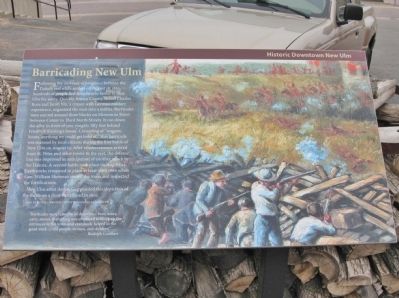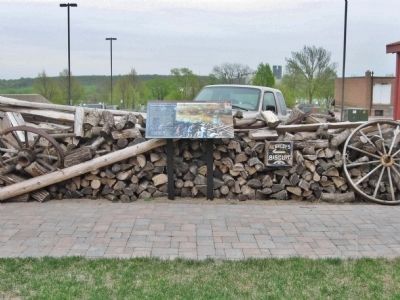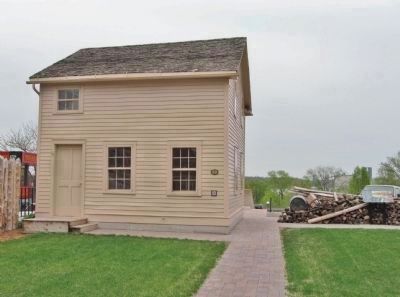New Ulm in Brown County, Minnesota — The American Midwest (Upper Plains)
Barricading New Ulm
Historic Downtown New Ulm
Following the outbreak of hostilities between the Dakota and white settlers on August 18, 1862, hundreds of people fled from nearby farms to New Ulm for safety. Quickly, Brown County Sherriff Charles Roos and Jacob Nix, a citizen with German military experience, organized the men into a militia. Barricades were erected around three blocks on Minnesota Street between Center to Third North Streets. It ran down the alley in front of you, roughly fifty feet behind Friedrich Kiesling's house. Consisting of "wagons, boxes, anything we could get hold of," this barricade was manned by local citizens during the first battle of New Ulm on August 19. After reinforcements arrived from St. Peter and other towns to the east, the defense line was improved in anticipation of another attack by the Dakota. A second battle took place on August 23. Earthworks remained in place at least until 1866 when Gen. William Sherman visited the town and inspected the fortifications.
New Ulm artist Anton Gag painted this depiction of the battle on a flour barrelhead in 1902.
Gag Painting: Brown County Historical Society
"Barricades were raised in all directions; barn doors, carts, stones, everything was employed to block up the entrances to the town, and everybody helped in the good work — old people, women, and children."
Rudolph Leonhart
Topics. This historical marker is listed in these topic lists: Settlements & Settlers • Wars, US Indian. A significant historical year for this entry is 1862.
Location. 44° 18.966′ N, 94° 27.664′ W. Marker is in New Ulm, Minnesota, in Brown County. Marker can be reached from North Minnesota Street south of 3rd North Street, on the left when traveling south. Marker is located at the Kiesling House. Touch for map. Marker is at or near this postal address: 220 North Minnesota Street, New Ulm MN 56073, United States of America. Touch for directions.
Other nearby markers. At least 8 other markers are within walking distance of this marker. Kiesling House (a few steps from this marker); Grand Hotel (within shouting distance of this marker); Buenger Store (within shouting distance of this marker); Pioneer Founders of New Ulm (about 400 feet away, measured in a direct line); German–Bohemian Immigrants Monument (about 400 feet away); U.S. - Dakota War Memorial (about 500 feet away); Crone Store (about 500 feet away); Dacotah House (about 500 feet away). Touch for a list and map of all markers in New Ulm.
Regarding Barricading New Ulm. In 1862, the Minnesota Dakota, also known by the French term, “Sioux," waged war against the United States following two years of unfulfilled treaty obligations. After attacking the Redwood (Lower Sioux) Agency on August 18, the Dakota moved toward New Ulm with speed and surprise, killing nearly everyone in their path.
In the Dakota War of 1862, 868 men, women, and children perished by actual count. Those killed whose remains were never found and the soldiers and citizens killed or mortally wounded in the hostile engagements with the Indians made the total death list number at least 950.
source: Monuments and Tablets Erected by the Minnesota Valley Historical Society, 1902
Also see . . .
1. 1862 Dakota War. "It was the largest Indian war in American history. The main battleground was the entire Minnesota River Valley in southern and central Minnesota. The uprising spread into the Dakota Territories and sent panic into Nebraska, Iowa and Wisconsin... Over 200 people were killed the first morning – as many as Custer lost at the Little Bighorn. To this day, that number of civilians killed on American soil as a result of hostile action is exceeded only by the attacks on 9/11." (Submitted on April 22, 2014.)
2. The U.S. - Dakota War of 1862. Minnesota Historical Society. "This was the largest battle over a US town since 1776." (Submitted on April 22, 2014.)
3. Battles of New Ulm. Wikipedia entry. "In all, 190 structures within the city were destroyed." (Submitted on April 22, 2014.)
Additional keywords.
U.S.-Dakota War of 1862
Credits. This page was last revised on June 16, 2016. It was originally submitted on April 22, 2014, by Keith L of Wisconsin Rapids, Wisconsin. This page has been viewed 935 times since then and 75 times this year. Photos: 1, 2, 3. submitted on April 22, 2014, by Keith L of Wisconsin Rapids, Wisconsin.


